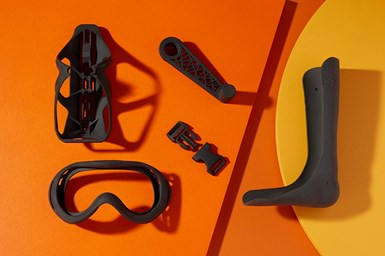Formlabs Develops Powder for Strong, Flexible End-Use Parts, Prototypes
The material’s characteristics enable users to print end-use parts that need to bend or take impact such as hinges, clips and orthotics.
Share
Read Next

Nylon 11 Powder’s ductile, strong and flexible characteristics make it well suited for end-use parts that must be able to take impact and handle wear and tear over time, including snaps, clips, and hinges.
Formlabs’ Nylon 11 powder is a high-performance nylon material developed for functional prototyping and small batch production. It is designed for use on Formlabs’ Fuse 1 high-performance selective laser sintering (SLS) 3D printer.
The material enables users to print parts that need to bend or take impact such as hinges, clips and orthotics, making it well suited for manufacturing, engineering, and health care uses. Nylon 11 powder is one of many materials Formlabs plans to launch for use with the benchtop Fuse 1 printer, which is designed to make industrial 3D printing more cost accessible and user friendly with its straightforward workflow.
The Nylon 11 powder was developed to bolster design and creation capabilities with low cost per part. It requires less training and additional equipment needed, compared to other PA11 materials on the market, the company says. This is said to expand the functionality of the Fuse 1 and enable users to print end-use parts that can handle wear and tear over time, all in-house.
The material is said to be optimal for products requiring durability and performance. Nylon 11 Powder’s ductile, strong and flexible characteristics make it well suited for end-use parts that must be able to take impact and handle wear and tear over time, including snaps, clips, and hinges. It also designed for use in manufacturing, production, engineering and product design to create impact-resistant prototypes, thin-walled ducts and enclosures, robust jigs and fixtures, replacement parts, and prosthetics and orthotics.
According to the company, using Nylon 11 powder with the Fuse 1 gives engineers, product designers and manufacturers design freedom, the ability to customize end-use parts, and speed in bringing products to market.
Related Content
-
How to Build 10,000+ Shot Molds in Hours
Rapid tooling isn’t so rapid when it takes days to 3D print a metal mold, and then you still must machine it to reach the necessary tolerances. With Nexa3D’s polymer process you can print a mold in hours that is prototype or production ready and can last for more than 10,000 shots.
-
How to Improve Polymer AM Productivity 20X
A fast cycle time is critical to efficient production 3D printing, but it’s not the only thing. How you choose the right parts for AM, prepare jobs for production, and manage post processing will have just as big an impact on total 3D printing throughput. It all needs to work together to achieve maximum productivity.
-
What is Powder Bed Fusion 3D Printing?
Whether in metal or polymer, with a laser or an electron beam, powder bed fusion (PBF) is one of the most widely used 3D printing techniques.












.png;maxWidth=300;quality=90)

